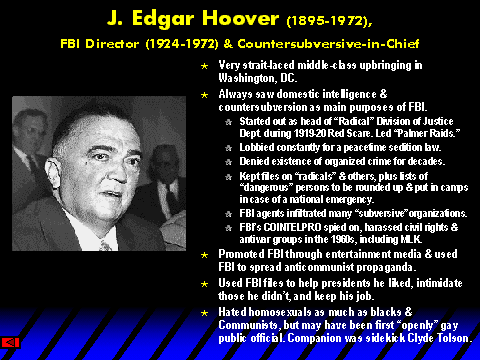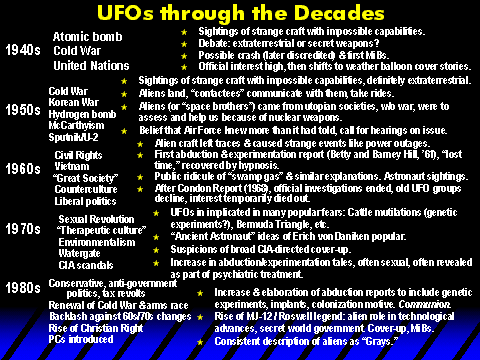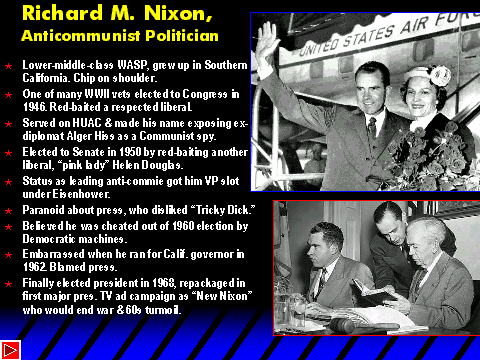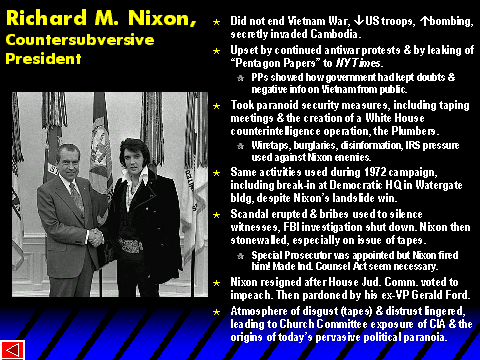The Origins of Modern Conspiracy Culture
7 December 2000
I. The Communists: The Greatest CT Villains of All
Why have Americans hated and feared communists and communism?
Opposed property & wealth, might cause workers to rebel. Nice tool against unions & left.
After rise of "totalitarianism" in Soviet Union, communism worst example of "big government."
In the Grand Tradition: Like many other CT villains, communism was associated with giving up individual will, "foreign influences," sexual deviance, and other forms of paranoia.
Religion: US was & is most religious country in world; Marx had called for the abolition of religion & actual Communist regimes persecuted churches & clergy.
In South, racism: Communists were almost only national political group (before 1950s), that showed amy sympathy for black rights. To many whites, civil rights=Communism.
Reality Check: The Communist Party in the United States
Really did want to spread revolution, did work with Moscow, were somewhat conspiratorial.
Size of the threat never huge: a maximum of maybe 100,000 members at its height in 1939, usually much less. Strong only in 3 limited & specific time periods:
Just after Russian Revolution of 1917: Immigrant worker conditions still awful, labor still repressed, seemed like Revolution might sweep world in a few years.
Led to 1919 "Red Scare," Palmer Raids, and the beginnings of the FBI.
During Great Depression of 1930s: Capitalism seemed about to collapse & Fascism (incl. Nazism) seemed like bigger threat. Communism very strong in early CIO & w/ intellectuals & artists.
Crested with "Popular Front" period of cooperation with wider left, faded after Stalin joined Hitler’s Axis in 1939. Picked up again after Germany attacked Russia in 1941.
To a lesser degree, during student movement of 1960s, but students preferred Asian Communists.
Never came close to seizing power, or even a little of it, in U.S.
By contrast, democratic socialism was much more successful in US: Socialist pres. candidate Eugene Debs got almost 900,000 votes in 1912 election.
By contrast, Communist parties in postwar Italy & France regularly got 20% of the vote.
Ironically, low point of CP in the U.S. (before recent times) was 1950s, when concern was highest.
II. Understanding Anticommunism
Anticommunist fallacies: Typical CT attribution of superhuman powers & pure evil.
Overestimated power and success of Communists around the world.
Overestimated the domestic CP and often showed more concern with fighting enemies within U.S. (liberals, Hollywood, academia) than the Soviets.
Assumed that Communist successes could only be caused by traitors & conspiracies. Examples: Chinese Revolution, Rosenberg case & Soviet development of atomic weapons.
Assumed that Communist beliefs could only result from evil, seduction, perversion, insanity, or coercion. Example: confessions at show trials & "brainwashing" of POWs.
Denial that any real social conditions or serious political beliefs could undergird communism.
Fear & fascination with idea that Commies could infiltrate western society & steal wills of individuals, making them pawns of a collective mind. Fed into 1950s fears of conformity. (clip)
Failed to analyze "hot spot" countries on their own terms, saw them only as gameboards or counters in the competition between Freedom & Tyranny. Example: Vietnam.
"Countersubversion," the worst aspect of anticommunist thought:
Believing that US faced a superhuman conspiracy, countersubversive thought argued that usual democratic methods were too weak to fight it. Had to fight fire with fire.
Hence typical American political values & rights such as free speech, due process, rule of law, loyalty to friends & family, openness, democracy, sympathy with oppressed peoples needed to be suspended where battling the Communist conspiracy was concerned. (clip)
Illustrations: Mickey Spillane’s "Mike Hammer", vigilante against Commies. Plus other films.
The Rise of Modern Anticommunism
House Un-American Activities Committee began in 1930s, as part of attack on New Deal.
Domestic spying by J. Edgar Hoover & the FBI, America’s not-so-secret police.

Fears exploded after WWII alliance broke up, Soviets extended influence over Eastern Europe (Czech coup, Berlin blockade), and the Cold War broke out, 1947-48. (Clip)
While Soviet moves were sinister, U.S. exercised similar influence in Latin America & Europe.
Assumption that Soviet goal was world conquest, and that it could really happen.
III. The Rise of the "National Security State"
Formation of National Security State: thinking like totalitarians to beat the totalitarians.
After World War II, government reorganized for a permanent state of war.
Military establishment kept much larger than after any previous war.
Military budgets increased, especially during 1950s, as new weapons were developed & deployed, new bases built, including secret ones like Area 51/Dreamland.
National Security Act of 1947
War Department became Department of Defense. (Pentagon built to house it.)
National Security Council & Central Intelligence Agency created to gather information, make decisions, & carry out actions, largely secretly & without public or congressional approval. Many CTS were launched.
Wartime patterns of secrecy, information management & paternalism continued & institutionalized. Most critical info & decisions done on "need to know" basis.
Cool, rational experts vs. emotional, irrational public, to be treated like children: scared witless for disciplinary/motivational purposes, reassured that everything would be OK if they obeyed Daddy .
Idea that public could not handle certain information.
Countersubversive Foreign Policy
"Containment" policy: stop spread of communism all around the world, through economic & military aid if possible, intervention if necessary.
US supported vicious right-wing dictators if they supported US & opposed Communism, such Batista in Cuba, Diem in Vietnam, Marcos in Philippines, Pinochet in Chile, Somoza in Nicaragua, military regimes in Guatemala & El Salvador, Shah of Iran.
A new pattern of more military action than ever but all conducted by executive branch, without congressional declarations of war: Korea, Vietnam, Persian Gulf.
Dangers: "national security" justified anything & left no one accountable.
CIA’s "MKULTRA"drug & mind-control program, to see if "brainwashing" really worked.
Nuclear testing, radiation experiments involving unsuspecting soldiers & citizens.
Early indication of instability: Soviet capture of U-2 spy plane, 1960, leading to admission of secret progam by Eisenhower.
IV. Fear, Distrust, and the Nuclear Arms Race
US became world’s greatest military power by using the newly-developed atomic bomb on Japan, twice, in Aug. 1945.
But reign did not last long, as Soviet Union developed its own A-bomb by 1949. Nuclear arms race broke out, lasting until 1980s.
Hydrogen bomb, 100 times more powerful than 1945 bomb, tested in Nov. 1952, but Soviets took only 9 months to match it.
Later a race developed over delivery vehicles, as ICBMs replaced piloted bombers. In late 50s, Soviet superiority in rocketry caused fears of a "missile gap."
Nuclear strategy: US adopted policy of responding to any Communist aggression by "massive retaliation" with nuclear weapons. Later developed into "deterrence" strategy, of making US nuclear arsenal so strong that enemy would fear to attack.
The rise of "civil defense" and nuclear education, as part of nuclear strategy:
Nuclear tests & effects (like radioactive "fallout") were widely publicized, emphasizing power of the weapons. So was danger of attack by Soviets.
At the same time, extensive efforts at "civil defense" were made, including drilling of schoolchildren & network of fallout shelters. Home bomb shelter craze. Clip
Goal was to increase deterrence by showing US could survive a nuclear attack.
In later decades, official nuclear strategy changed to MAD ("mutually assured destruction’), more truthful but not much more comforting.
Nuclear paranoia & the beginnings of political distrust:
Massive fear & paranoia created by bombarding people with images of nuclear destruction & idea that it could happen anywhere, at anytime.
Contradiction between government propaganda/civil defense measures & obvious facts about nuclear weapons, such as that few would likely survive a nuclear war & that radiation effects would last much longer than a few minutes.
Controversies over radioactive contamination from nuclear testing.
End of the world by nuclear holocaust & mutations caused by radiation became common themes of pop culture, from science fiction films to country music.
The generation of kids who went to school in the 50s (the baby boomers) grew up to distrust government & fear technology. "Credibility gap" began early.
First major UFO scare coincided with outbreak of Cold War & arms race.
1st wave of sightings in came in June and July 1947:
Pilot Kenneth Arnold saw lights "like a saucer . . . skipped . . . across the water."
Maury Island incident, partial hoax involving secret aircraft & first "man in black."
Wide publicity & world-wide wave of sightngs. Mantell crash, 1948.
"Saucer crash" near nuclear base at Roswell, N.M.: Air Force originally reported it had recovered a spacecraft, but explanation later changed story to debris from secret Skyhook balloon project. Claims of bodies found & secret removal of debris from base.
Air Force investigations (Projects Sign, Grudge, Blue Book) took stuff seriously at first, coined term UFO, fearing enemy technology, then began debunking claims.
Followed bymore waves of U.S. sightings in 1950, 1952 (in D.C.) and after.
Alien invasions became part of popular culture, too, often as allegories of Communists infiltration, nuclear destruction or both.
UFO beliefs seemed to track cultural changes in later decades.

V. Rise and Fall of Anticommunist Politics
Anticommunism as a political tool: Republicans & other conservatives came to rely heavily on the power of ""red-baiting," using CTs & accusations of Communism to discredit all liberals, leftists, reformers, critics of US society.
Republicans crushed by Great Depression & FDR, but came back beg in 1946 by red-baiting.
President Truman forced by red-baiters to prove its anticommunism & accepted many aspects of countersubversive thought.
Truman’s loyalty program began Mar. 1947 & strengthened after: Required loyalty oaths & background investigations of gov. employees & applicants. Homosexuality as bad as communism.
Under Smith Act (1938-39), McCarran Act (1950), & Communist Control Act (1954), Communism became only illegal political opinion/organization in American history.
Successful red-baiting led to wave of congressional investigations of Communist subversion in goverrnment and other institutions.
Most successful red-baiting politician: congressman, senator, VP Richard Nixon.
The Era of "McCarthyism," 1950-54
Obscure Wisconsin senator used wild, unsubstantiated charges & hints of secret knowledge. Never produced a Hiss or Rosenberg case, but got lots of publicity, especially through televised hearings.
McCarthy investigations only one category. Others by HUAC, FBI, press, state & local committees.
Cultural McCarthyism: Blacklisting & pressure to prove "loyalty" by naming friends to investigators.
Targets were usually Hollywood figures, professors & minor government officials , based on Communist activities and associations from the 1930s. Many careers ruined or forced underground.
McCarthy fell from power after his investigation of communism in the military led to Army-McCarthy hearings (1954), in which McCarthy himself became the target. McCarthy censured by Senate.
Aftermath: The Liberal Consensus, 1954-64
Backlash against McCarthy ushered period of "liberal consensus" which opposed extremes of right and left (including communism) but regarded red-baiting and McCarthyism as distasteful.
Extreme anticommunism taken up by new far right groups such as the John Birch Society.
Scholars and commentators of liberal consensus psychoanalyzed radicals and conspiracy theorists, applying the diagnostic term "paranoid" to their beliefs. Peaked with 1964 Goldwater campaign.
Lingering fear of red-baiting helped push Johnson into the Vietnam War.
Liberals were totally unprepared for burst of anti-government extremism & paranoia on both sides that followed in 1960s through 1980s.

